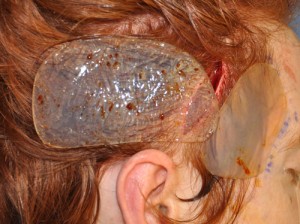The sides of the head, known as the temporal regions, is made up of the overlying temporalis muscle and the underlying temporal bone of the skull. What separates the temporal region on the visible outside is hair. The temporal hairline stops before reaching the side of the orbit leaving a strip of skin that runs from the zygomatic arch up to the forehead. This is an area that can develop the most visible temporal hollowing, is usually referred to when talking about the temples, but is what I call the anterior temporal region. Any part of the temporal region that lies in the hair bearing area is known as the posterior temporal region and extends back to behind the ear.


The temporal implants are easily slide into place and the fascia can be closed over the posterior end of the anterior implant and the anterior end of the posterior implant. Closing of the fascia is not mandatory, and is what will cause some temporary postoperative stiffness on oral opening, but creating a tissue layer between the implant and the skin always seems like a good idea.
Total widening of the head can be done using subfascial anterior and posterior temporal implants. They are straightforward to place and do not cause any undue amount of swelling or prolonged postoperative recovery. Typically most patients will look fairly normal in 7 to 10 days after the procedure.
Dr. Barry Eppley
Indianapolis, Indiana



